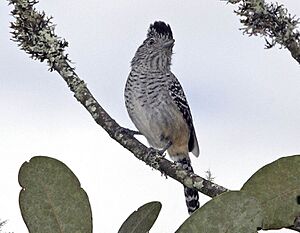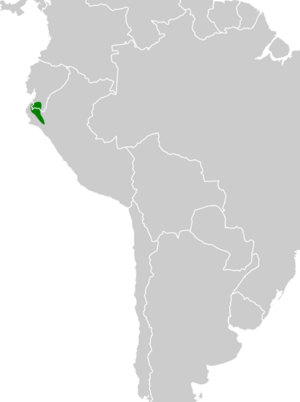Chapman's antshrike facts for kids
Quick facts for kids Chapman's antshrike |
|
|---|---|
 |
|
| Conservation status | |
| Scientific classification | |
| Genus: |
Thamnophilus
|
| Species: |
zarumae
|
 |
|
The Chapman's antshrike (Thamnophilus zarumae) is a cool bird that lives in Ecuador and Peru. It's part of the "typical antbird" family, which means it's related to other birds that often eat ants. This bird is known for its unique look and interesting calls.
Contents
About This Bird
Chapman's antshrike was first thought to be its own species. But then, scientists decided it was a type of barred antshrike. Later, they changed their minds again! Now, it's back to being its own special species. This shows how scientists learn more over time.
There are two main types, or subspecies, of Chapman's antshrike. They are called T. d. zarumae and T. d. palamblae.
What It Looks Like
Chapman's antshrike is about 14 to 15.5 centimeters (5.5 to 6 inches) long. It weighs around 22 grams (less than an ounce). Birds in the Thamnophilus group are fairly large antbirds. They all have strong beaks with a hook, a bit like a shrike bird.
Males and Females Look Different
Male and female Chapman's antshrikes look quite different. This is called sexual dimorphism. Both sexes have a fluffy crest of feathers on their heads.
- Adult males of the T. d. zarumae type have a black and white striped forehead. Their crown and crest are black. Their face and neck sides are also striped black and white. They have a gray "collar" around their neck. Their back, shoulders, rump, tail, and wings are black with white stripes. Their throat is white with black stripes. Their chest and sides are white with light black stripes. Their belly is plain white. Their lower sides and under-tail feathers are a cinnamon-buff color.
- Adult females have a reddish-brown crest. The sides of their head and neck are whitish-buff with black stripes. Their collar is olive-brown. Their upper body, wings, and tail are cinnamon-reddish-brown. Their throat is light buff with thin black stripes. Their chest, belly, and sides are buff with faint gray marks on the chest.
Both male and female adults have light-colored eyes. Their upper beak is black, and their lower beak is blue-gray. Their legs and feet are also blue-gray.
Young Birds and Subspecies Differences
Young males have black and cinnamon-buff stripes. Their flight feathers are dark instead of black.
Males of the T. d. palamblae type have lighter white stripes on their upper parts. Their belly is more buff, and their lower sides and under-tail feathers are a deeper orange-brown. Females of this type have darker upper parts than the other type. Their crown is a darker reddish-brown, and their lower sides are a deeper orange-brown.
Where It Lives
Chapman's antshrike lives in separate areas, which is called a disjunct distribution.
- The T. d. zarumae type is found in southwestern Ecuador. It lives in the El Oro and Loja provinces. From there, it goes south into Peru's Tumbes and northeastern Piura areas.
- The T. d. palamblae type lives in Peru. It is found in southeastern Piura and eastern Lambayeque.
This bird likes to live inside and at the edges of forests. These forests can be deciduous (trees lose leaves) or semi-deciduous. It also lives in younger, regrowing woodlands. It prefers thick plants, especially areas with lots of vines. It usually stays in the lower to middle parts of the forest.
In Ecuador, it mostly lives at heights between 800 and 2,000 meters (about 2,600 to 6,500 feet). In Peru, it lives mostly between 600 and 2,100 meters (about 2,000 to 6,900 feet). Sometimes, it can be found as high as 2,600 meters (about 8,500 feet).
How It Behaves
Movement
Chapman's antshrike stays in its home area all year long. It does not migrate.
Feeding
We don't know everything about what Chapman's antshrike eats. But we do know it eats things like caterpillars, grasshoppers, and spiders. It has also been seen eating berries from a type of Meliaceae tree.
This bird usually looks for food alone or in pairs. Sometimes, it joins groups of different bird species that are feeding together. It searches for food in thick plants from near the ground up to about 15 meters (50 feet) high. It hops between branches. It also climbs on branches and vines to pick insects off leaves, stems, and tree trunks. It has even been seen looking inside small bromeliad plants for food.
Breeding
Scientists don't know much about how Chapman's antshrike builds nests or raises its young.
Vocalization
The song of Chapman's antshrike is a fast series of 12 to 14 nasal notes. Then it has three higher-pitched, loud notes. It ends with a short rattle or trill. Some people describe it as "pew pew-pew-pwe'pu'puPEWpee pew-trr'eh".
Its calls include a nasal "nah" sound. It also makes a high, falling, meowing whistle that sounds like "peew". Another call is a sudden "chup".
Its Future
The IUCN (International Union for Conservation of Nature) says Chapman's antshrike is of "Least Concern." This means it's not currently in danger of disappearing. However, it lives in a small area, and we don't know exactly how many there are. Scientists think its numbers might be going down.
A lot of the land where this bird lives has been cleared for farms. This means its home is being destroyed. But, the Tumbes National Reserve in Peru helps protect a good amount of this bird's habitat. Some experts believe it should be considered more at risk.


